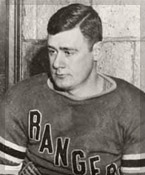Bun Cook: Developer of slap shot, drop pass
Brothers Bill and Fred "Bun" Cook began their hockey careers on the ponds and rinks of Kingston, before ascending to fame and glory in the National Hockey League. Ultimately, their journey would end with both being inducted into the Hockey Hall of Fame, recognized among the greatest legends to ever play the game. While Bun was overshadowed somewhat by his older brother Bill, he was a fine player in his own right - and he might have been an even better coach than a player.
Bun Cook was born in Kingston on Sept. 18, 1903, seven years younger than older brother Bill. He played hockey for St. Mary's School in Kingston before moving to Brantford when he was 1 5 to play junior hockey. Next he migrated to Sault Ste. Marie, where he played both junior and senior hockey and was a member of the 1923-24 Allan Cup-winning team. When brother Bill returned from the First World War, they moved west to farm and wound up joining the semi-pro Saskatoon Sheiks. Both were stars in the Western Canada Hockey League in the mid-1920s, but when the league ran into financial difficulties, the brothers were purchased by the fledgling New York Rangers, a new National Hockey League team.
5 to play junior hockey. Next he migrated to Sault Ste. Marie, where he played both junior and senior hockey and was a member of the 1923-24 Allan Cup-winning team. When brother Bill returned from the First World War, they moved west to farm and wound up joining the semi-pro Saskatoon Sheiks. Both were stars in the Western Canada Hockey League in the mid-1920s, but when the league ran into financial difficulties, the brothers were purchased by the fledgling New York Rangers, a new National Hockey League team.
The Cook brothers, along with centre Frank Boucher, formed the NHL’s highest scoring line for about a decade, helping the Rangers win Stanley Cups in 1928 and 1933. Bun was the defensive specialist on the line but he could also score. During his career with the Rangers, he tallied 158 goals and 144 assists for 302 points in 473 regular-season games. He added 15 goals and 3 assists in 46 playoff games.
"Quick as a bunny"
Bun Cook was renowned for his fast skating; indeed, his fleetness on the blades inspired a sports journalist to write that he was "quick as a bunny," which, shortened to "Bun," became his nickname. He is also recognized as a hockey innovator who helped introduce the slap shot and drop pass to the game. As he once said, "I had a dream about the drop pass one night and at our next practice, I told Frank and Bill about it. They thought I was crazy, but they decided to humour me. By gosh, it worked! I'd cross over from left wing to centre as I moved in on the defence. I'd fake a shot and leave the puck behind and skate away from it, with Frank or Bill picking it up. We got a lot of goals off the criss-cross and drop pass."
Indeed, the line was known for its strong passing game. "Men who know would credit Bunny Cook with the introduction of the passing attack," wrote Frank Selke. "The Cook-Boucher line introduced a style of attack completely their own - each member kept working into an open spot, passing the puck carefully and adequately and frequently pushing the puck into the open net after confusing the defensive force of the opposition. This was a repetition of lacrosse as played by the great Indian teams."
A great success at coaching
Bun Cook retired as a player after a brief stint with the Boston Bruins in the 1936-37 NHL season, then turned to coaching where he enjoyed great success. Coaching in the American Hockey League with Providence and Cleveland, he led his teams to the playoffs in 18 of 19 seasons and won seven Calder Cup championships. The most championships won by any coach in the history of the AHL (no other AHL coach has won more than three), his 636 career coaching wins is also an AHL record that still stands today.
After retiring from the coaching ranks, Bun returned to Kingston in the late 1950’s and spent three seasons as a trainer with the Kingston Frontenacs of the Eastern Professional Hockey League. He died in 1988 at the age of 84.
Bun Cook was inducted into Kingston’s International Hockey Hall of Fame in 1966 and to the Hockey Hall of Fame in Toronto in 1995.